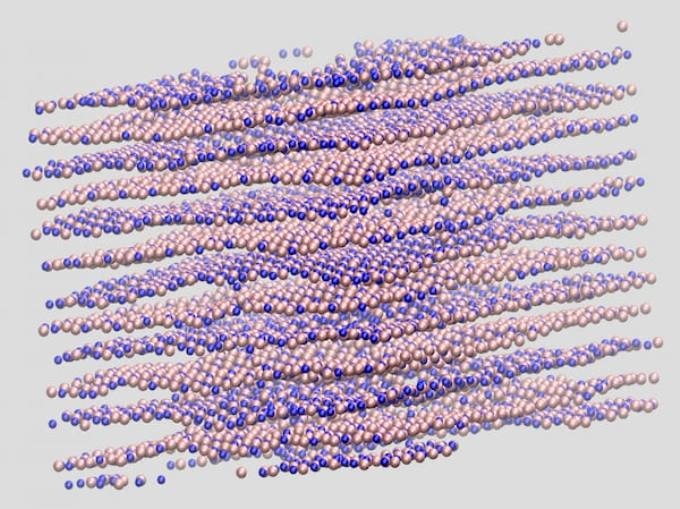Apr 11 2019
New two-dimensional (2D) materials are being discovered by researchers at a fast pace, but they do not necessarily immediately know the properties of those materials.
 Rice University researchers used a microstructure model of radiation-damaged hexagonal boron nitride to help them study the benefits of deep learning techniques in simulating two-dimensional materials to understand their characteristics. (Image credit: Prabhas Hundi)
Rice University researchers used a microstructure model of radiation-damaged hexagonal boron nitride to help them study the benefits of deep learning techniques in simulating two-dimensional materials to understand their characteristics. (Image credit: Prabhas Hundi)
Scientists at Rice University’s Brown School of Engineering say they can discover quickly by feeding standard details of their structures to “deep learning” agents that have the ability to map the materials’ properties. Moreover, the agents can rapidly model materials that scientists plan on creating to enable the “bottom-up” design of 2D materials.
Rouzbeh Shahsavari, an assistant professor of civil and environmental engineering, and Rice graduate student Prabhas Hundi investigated the abilities of neural networks and multilayer perceptrons that take limited data from the replicated structures of 2D materials and make “reasonably accurate” predictions of their physical features, such as strength, even after they are damaged by high temperatures and radiation.
Shahsavari said that following trained these agents could be modified to examine new 2D materials with as little as 10% of their structural data. That would return an assessment of the material’s assets with about 95% accuracy, he said.
“This suggests that transfer learning (in which a deep-learning algorithm trained on one material can be applied to another) is a potential game-changer in material discovery and characterization approaches,” the researchers proposed.
The findings from their extensive tests on graphene and hexagonal boron nitride have been published in the journal Small.
After the discovery of graphene in 2004, atom-thick materials have been hyped for their strength and variety of electronic properties for electronics and composites. Since their atomic arrangements have a major impact on their properties, scientists frequently use molecular dynamics simulations to examine the structures of new 2D materials even before attempting to create them.
Shahsavari said deep learning delivers an important speed boost over such traditional replications of 2D materials and their features, allowing calculations that presently require days of supercomputer time to run in hours.
“Because we can build our structure-property maps with only a fraction of the data from graphene or boron nitride molecular dynamics simulations, we see an order of magnitude less computational time to get a full behavior of the material,” he said.
Shahsavari said the lab planned to examine graphene and hexagonal boron nitride for their high tolerance to weakening under high temperatures and in radiation-rich settings, crucial properties for materials in nuclear power plants and spacecraft. Since the Shahsavari team had already performed over 11,000 radiation cascade damage molecular dynamics simulations for another paper on 2D materials, they had the motivation to see if they could replicate their results with a much faster technique.
They ran numerous deep learning simulations on 80 combinations of temperature and radiation for hexagonal boron nitride and 48 combinations for graphene, targeting each combination with 31 random doses of simulated radiation. For a few, the scientists trained the deep learning agent with a maximum of 45% of data from their molecular dynamics research, realizing up to 97% accuracy in predicting flaws and their effects on the material’s features.
Adapting trained agents to various materials, they learned, required just about 10% of the simulated data, significantly accelerating the process while preserving good accuracy.
“We tried to figure out the corresponding residual strengths of the materials after exposure to extreme conditions, along with all the defects,” he said. “As expected, when the mean temperature or the radiation were too high, the residual strength became pretty low. But that trend wasn’t always obvious.”
In certain cases, he said, the combined higher radiation and higher temperatures rendered a material stronger instead of less, and it would help scientists to know that before creating a physical product.
“Our deep learning method on the development of structure-property maps could open up a new framework to understand the behavior of 2D materials, discover their non-intuitive commonalities and anomalies, and eventually better design them for tailored applications.”
Rouzbeh Shahsavari, Assistant Professor, Civil and Environmental Engineering, Rice University.
The National Science Foundation (NSF) supported the study. Computing resources were aided by the National Institutes of Health, an IBM Shared University Research Award in collaboration with Cisco, Qlogic and Adaptive Computing, and the NSF-supported DAVinCI supercomputer administered by Rice’s Center for Research Computing and acquired in a collaboration with Rice’s Ken Kennedy Institute for Information Technology.